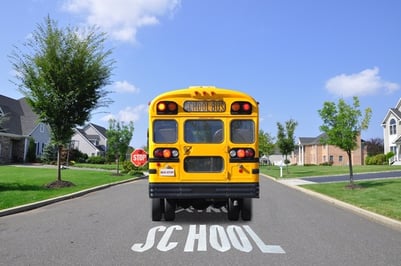Does Student Tracking Ensure Safer Bus Rides?
published on June 07, 2022 by Sonia Mastros
route optimization, Student Safety, Student Tracking Software, student tracking systems, school bus routing software, school bus driver shortages, inefficient routes, outdated routes, inaccurate routes, route efficiency, state reporting, re-routing, bus shortages

Despite some initial controversy, RFID-based student tracking systems are beginning to be utilized around the country to make student bussing safer and more effective.
In just the last couple years, programs have been implemented in cities across America. Consistently, the reports have been positive: student tracking truly does help keep students safe, as well as giving districts numerous new ways to optimize their busing.
In the meantime, the fears that this would somehow turn into a "Big Brother" scenario are being shown as unfounded. The potential for gain is great, with very little actual potential for abuse.
While the initial system installation can require a substantial up-front outlay, this investment is quickly rewarded.
Five Ways RFID Student Tracking Creates Better Bus Rides
1) No-Question Bus Ridership Tracking
With RFID scanners on your buses, there's rarely any question as to whether a student rode a bus. After all, they're being recorded every time they get on or off. This, in turn, is transmitted instantly to your servers in the office.
Besides the obvious benefits to your state reporting, this greatly reduces the chances of miscommunication between parents, students, and drivers. If a parent discovers they're unsure whether their child got on the bus, all it takes is a couple mouse-clicks to discover the truth.
2) Improper Departure Alerts
Another benefit to this tracking system is that, when it's tied to a GPS system, the computers will instantly know which students are supposed to get off at which stops. If a student tries to leave the bus at the wrong stop, the driver is immediately alerted so they can assess the situation.
Generally, bus drivers are given some discretion when one child is getting off with a known friend. On the other hand, if a student is simply confused, a potentially dangerous mishap is avoided entirely.
3) Medical Alerts
When a student's records are tied to their bus routing, it means drivers can always be alerted if a student with special medical needs is riding. Students with respiratory or cardiac conditions can be placed where the driver can keep an eye on them.
By the same token, should a legitimate medical emergency occur, the integrated tracking system will speed dispatch response. You'll know within a couple feet where the bus is from the moment it comes to a stop. So, you can already be getting ready to send out assistance.
In situations where minutes can make the difference between life and death, onboard bus tracking systems greatly improve the odds.
4) Truant Student Detection
It happens: A student arrives on the bus in the morning, but then "somehow" ends up behind the gymnasium rather than appearing in class. Or they may simply walk right back off campus before anyone sees them.
Student tracking makes these sorts of games far less likely to work. If you have scanners on your school doors, for example, the system will expect to see the student pass through within a few minutes of delivery. If it doesn't happen, you can be alerted.
Similarly, a few RFID scanners around your perimeter mean you'll know quickly if a student is trying to ditch.
5) More Power to Your Drivers
While it's been a running theme, it's worth explicitly mentioning the improvements to your drivers' experience. Onboard bus tracking systems can take a lot of burdens off their back, leading to better morale and more effective driving:
-
No more annoying hand-written checklists or sign-in sheets.
-
Complete performance tracking reduces their need to manually record bus usage data.
-
Clear and unambiguous onboard maps point them to every logged student's stop.
-
Faster calls for support when help is needed.
-
No chance of getting lost with GPS systems.
In short, these tracking systems help keep your drivers "in the loop," empowering them to make decisions more easily while reducing bureaucratic burdens.
Are There Downsides To Student Tracking?
There are remarkably few arguments against RFID tracking, besides the initial installation costs. Otherwise, the most common reported problems are:
-
Parents misunderstanding the system, and overestimating its effects on privacy. This can be addressed with better communications.
-
Students wrapping their ID badges in tinfoil to defeat the RFID tracker. However, this is easily countered with a visual check.
-
Lost cards, which will be an unavoidable ongoing cost.
That said, the overall safety and reporting improvements should vastly outweigh the expenditures associated with replacing lost cards.
Is It Time For Bus Tracking?
On-bus student tracking systems can quickly make your bus routes safer, your drivers happier, and your state reporting easier. The combined cost savings virtually always outweigh the investment, not to mention the ease of mind they bring to both parents and administrators.
To learn more about the power of RFID student tracking, simply contact us to receive a free consultation!
What do you think? Are there other aspects of student tracking that can help ensure safer bus rides? Let us know in the comments below!



